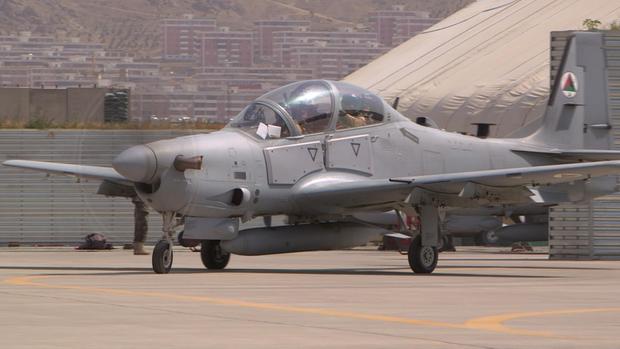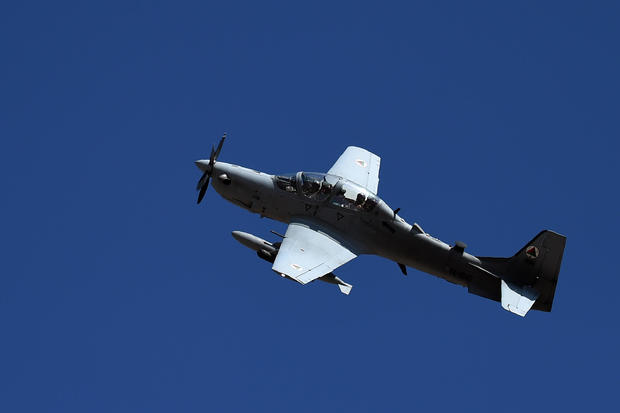CBS This Morning travels to Kabul to see how the A-29 is helping the Afghan Air Force.
This report appeared on CBS This Morning and can be found here.
KABUL — Secretary of State Rex Tillerson says the United States wants to force the Taliban to the negotiating table in Afghanistan. At a Tuesday press briefing, he contradicted President Trump’s assertion that the administration’s new strategy in America’s longest-running war is about total victory.
Afghan President Ashraf Ghani thanked President Trump and the American people for their continued support here this week. At the top of the list, he mentioned the development of the Afghan Air Force.
Watch the video here:
CBS News correspondent Charlie D’Agata recently got the rare opportunity to watch U.S. fighter pilots training new Afghan pilots on how to wage war over Afghanistan’s not-so-friendly skies.
The fleet they’re being trained on doesn’t necessarily resemble what most Americans would consider modern aircraft, but then, the Afghan military’s long fight against the Taliban could hardly be described as a modern war.
Brigadier General Phillip Stewart tells CBS News the help in the air could just help the Afghan’s break the stalemate with the Islamic extremist insurgents.
“This is a country that screams out for air power,” Stewart said. “It doesn’t have a whole lot of roads. It’s mountainous.”

A U.S.-built A-19 Super Tucano aircraft, now a part of the Afghan Air Force fleet, is seen on the tarmac at a base where U.S. Air Force pilots are training their Afghan counterparts to battle the Taliban. (CBS News)
That terrain suits the new Afghan fighter division, which consists of a 12 American-built A-29 Super Tucano planes and about two-dozen MD-530 attack helicopters, capable delivering a full payload, and equipped with heavy machine guns and guided missiles.
U.S. combat pilot Lt. Colonel Johnnie Green is in charge of handling Afghanistan’s “Top Guns,” and he tells CBS News the aircraft are fully equipped with communications equipment to enable Afghan Air Force pilots to get targeting information directly from their own personnel on the ground, “all in their own language. That is all on them.”
So is the maintenance. The A-29s, single-propeller planes, use the same kind of engines found in planes like civilian Cessnas, so they’re easy to fix.
After that, they said, ‘we should hide.'” Now, if a group of militants hear the growl of an A-29 engine approaching, they try to get to cover.
“An aircraft like this is not going to hold its own against an air force like the Russians or China,” Lt. Colonel Green told CBS News. It’s not designed to, but in this war, it “suits the Afghan Air Force just fine.”
Asked by D’Aagta whether that makes it an unfair fight with the Taliban, Green replied: “We hope so. In our favour… that’s the desire.”
And it’s a mission on fast-forward; Afghan pilots come out of U.S. training and head straight into combat.
With the Taliban still gaining ground, the only advantage Afghan troops have is above it.
As recently as Tuesday, U.S. Air Force officials said they were not only examining ways to expand the training of the Afghan Air Force, but also looking at ramping up American air power and intensifying U.S. airstrikes in light of Washington’s new military strategy in Afghanistan.
The planes are also capable of dropping laser-guided 500-pound bombs, which makes them both cheap and deadly.

An Afghan Air Force A-29 Super Tucano aircraft flies during an airstrike training mission on the outskirts of Logar province, in a Oct. 18, 2016 file photo. (CBS/Getty)
“An aircraft like this is not going to hold its own against an air force like the Russians or China,” Lt. Colonel Green told CBS News. It’s not designed to, but in this war, it “suits the Afghan Air Force just fine.”
Asked by D’Aagta whether that makes it an unfair fight with the Taliban, Green replied: “We hope so. In our favor… that’s the desire.”
And it’s a mission on fast-forward; Afghan pilots come out of U.S. training and head straight into combat.
With the Taliban still gaining ground, the only advantage Afghan troops have is above it.
As recently as Tuesday, U.S. Air Force officials said they were not only examining ways to expand the training of the Afghan Air Force, but also looking at ramping up American air power and intensifying U.S. airstrikes in light of Washington’s new military strategy in Afghanistan.
